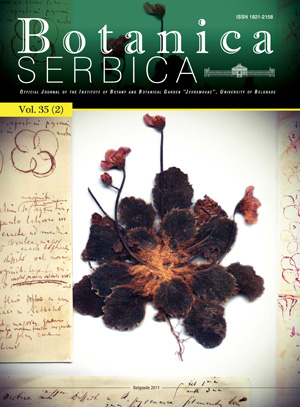
Volume 35 Issue 2 2011 |
The natural priority habitats in the Alpine zone of Bucegi Massif (Romanian Southern Carpathians) |
KEY WORDS: Natura 2000, phytocoenoses, priority species |
Anemone L. (Ranunculaceae): comparative morphology and taxonomy of the species from the Balkan flora |
KEY WORDS: Balkan peninsula, Anemone species, essential morphological characters, taxonomy. |
An insight into fatty acid chemistry of Rhytidiadelphus squarrosus (Hedw.) Warnst. |
KEY WORDS: moss; Rhytididelphus squarrosus; fatty acids; GC FID; GC-MS. |
Novelties for the vascular flora of Serbia |
KEY WORDS: Serbia, fl oristic novelties, Mediterranean and Pontic species, distribution, threatened status |
Variability in stomatal features and leaf venation pattern in Indian coffee (Coffea arabica L.) cultivars and their functional significance |
KEY WORDS: Coffea arabica, Stomatal features, Leaf architecture, Minor venation, adaptation |
Typha shuttleworthii in Ukraine and adjoining regions: tendencies of dynamics of distribution, ecological and coenotic peculiarities |
KEY WORDS: Typha shuttleworthii, area, distribution, ecology, communities, threats. |
Distribution of Carex distachya in Albania |
KEY WORDS: Mediterranean, Carex, oak forest |
Observations on the subterranean system of Smilax goyazana (Smilacaceae) |
KEY WORDS: Culm, Rhizome, Saponin, Vegetative Propagation |
Can we predict mutagen-induced damage in plant systems mathematically? Insights from zygotic embryo and haploid mutagenesis in Indian mustard (Brasica juncea) |
KEY WORDS: Indian mustard, Brassica juncea, LD50, multiple regression, haploid mutagenesis |
Anatomy of four taxa of the genus Juniperus sect. Juniperus (Cupressaceae) from the Balkan peninsula |
Macroscopic and microscopic analyses were done on samples of 13 populations from Eu- Mediterranean coastal areas of up to 2,000 m a.s.l. in continental mountains. Descriptive statistics were calculated for 23 quantitative characters. Canonical Discriminant Analysis (CDA) and clustering on the basis of the UPGMA method were performed to measure distances between the groups. At an anatomical level there was fi ne diff erentiation between the taxa, at the level of species and subspecies. Th e species J. communis and J. deltoides differed in number of stomatal bands, needle cross-sectional shape, dimensions of the needle resin duct, as well as in the structure of the central cylinder in the primary structure of the stem. Within the species J. communis, high mountain subspecies J. communis subsp. alpina was finely differentiated compared with the typical subspecies J. communis subsp. communis. Basic differences between these two taxa were reflected in the shape and dimensions of the needles. Discriminant and cluster analyses did not show any major differences between J. communis subsp. communis var. communis and J. communis subsp. communis var. intermedia. Multivariate analysis showed that the level of anatomical diff erentiation of these taxa were conditioned partially by phylogenetic association of individual taxa, and partially by ecological conditions of the habitat. Our results showed that anatomical characteristics of needle and primary structures of the stem of these species of genus Juniperus have taxonomic signifi cance at the species and infraspecies levels. KEY WORDS: Juniperus communis, J. deltoides, anatomy, needles, primary and secondary stem. |
New chorological data and floristic notes for Albania |
KEY WORDS: Albanian fl ora, Balkan Peninsula, distribution, endemic, new records |
University of Belgrade Herbarium – treasury of data and challenges for future research |


